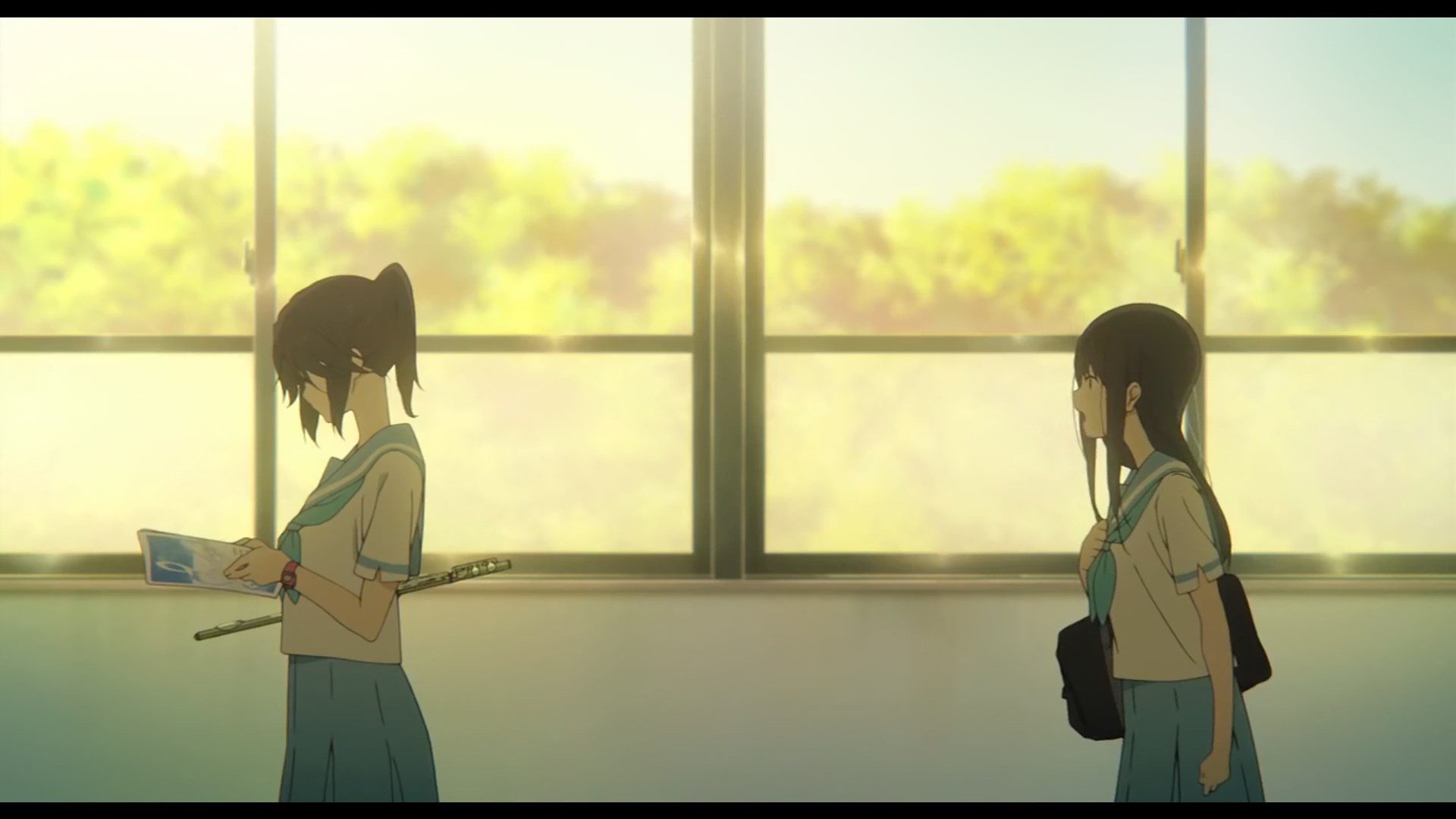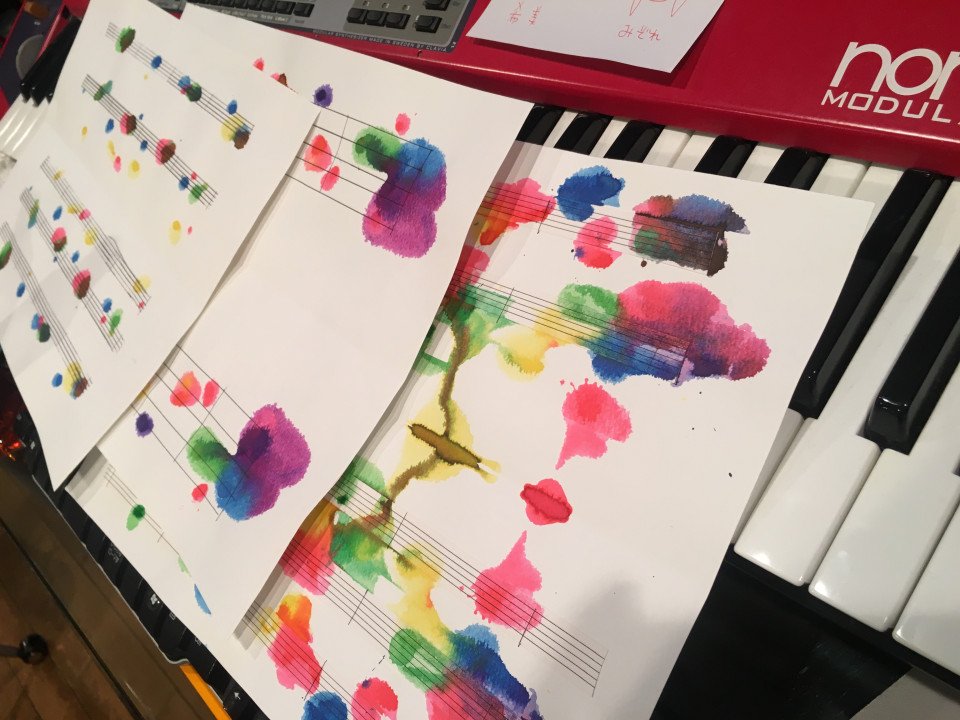
A New Step For A Silent Voice’s Team: Liz And The Blue Bird Impressions [Annecy 2018]
The team behind A Silent Voice, captained by Naoko Yamada, has returned with a fascinating little film that challenges regular anime production methods to organically interweave visuals and sound, applies mathematical concepts to the depiction of interpersonal relationships, and crafts gorgeous scenes in entirely non-standard ways. For those of you looking forward to Liz and the Blue Bird, this is what you should expect from this quietly unique experience. And don’t worry, no narrative spoilers ahead!
Out of all the upcoming anime movies we got to sample at the Annecy film festival, this was the trickiest one to write about, as well as the one that left the biggest personal impression. Neither of those points are a consequence of the film being particularly complex or even all that interesting from a strictly narrative standpoint. If you were to forcibly detach its story from the way it’s told and examine it with a clinical lens, all you’d see is a simple and thematically light tale. I don’t believe that’s the right way to approach it of course, but it very much limits its audience from the get-go – and not in the way you could have initially assumed, since it’s perfectly approachable even if you’ve never even heard of the Euphonium franchise.
Liz and the Blue Bird is a story about mutual love, and yet the pieces of the puzzle that compose it don’t fit together. For shy oboe player Mizore, the one person who cheerfully approached her when no one else would might as well represent the whole world. But for the sociable Nozomi, even a bond as important as this is only one of the many relationships in her daily life. The disconnect between their feelings of affection is illustrated in the original work via the fairy tale that gave its name to this film and that supports its structure; the life of a lonely woman becomes more joyful than ever after she meets a mysterious girl, but once she realizes that it was in fact a bird taking human form to keep her company, she needs to grapple with her own feelings. The unhealthy desire to monopolize a loved one versus the painful decision to let them roam free and live up to their boundless potential is the dilemma at the core of this movie… with a bit of a twist at the end, which likely won’t surprise you but is delivered with perfect timing.
That conflict is compelling in its own right, but the team behind this movie wanted to take it further. To incorporate the dilemma into the production of the film, giving it audiovisual form somehow. The core staff came up with two keywords to build upon: disjoint and coprime numbers. The former is self-explanatory, while the latter is director Naoko Yamada‘s attempt to apply mathematical concepts to filmmaking; the lack of a common divisor beyond 1 is meant to represent the inability between the two main characters to connect beyond the basic fact that they love each other. This of course brings to mind her usage of mathematical limits in A Silent Voice to represent the dynamic between Shouya and Shouko – two people who will never be equal but are similar as they approach infinity. She came up with that idea while visiting the Critical Resemblance House and that had such an impact on her that she made it appear during the movie, but as seen in her new work, borrowing concepts from entirely different disciplines to portray human relationships has become a common strategy of hers.
However, to turn those fascinating concepts into an actual movie, its production had to follow a non-standard path. Yamada first had talks with composer Kensuke Ushio to decide on the rhythm of every scene and draw the storyboards based on that particular tempo. Those would then be animated and used as the basis to create the audio, which once again blurs the lines between SFX and soundtrack as many of his compositions were based on environmental sounds they recorded while visiting real schools; “We drummed on the chairs, rubbed the windows, hit the lockers, and scraped a beaker with a [violin] bow. Then we used these sounds to create the music.“, Ushio reminisces. The result to this unique way to create anime is made immediately obvious: the movie starts with a 5 minute-long scene that features virtually no dialogue, where the protagonists’ walking takes the spotlight. The lack of harmony at first – Mizore’s 60 beats per minute footsteps versus Nozomi’s 110 – sets the tone for their asymmetrical relationship, all while starting to build up towards the conclusion. Once they begin seeing eye to eye, a similar scene features Mizore’s footsteps at 100 BPM, while Nozomi has slightly slowed down her tempo to oscillate between 99 and 101 – two numbers that are again relatively prime, tying it all back together. It’s only during 4 seconds that the two exactly match, proving how hard it is to truly be in sync… and to talk about a movie like this without being able to share clips of it, for that matter. Though to a degree that’s true of most good movies, the obscenely deliberate execution is what makes Liz so special.
Though that fundamental disruption of how anime is made in the first place is what stands out the most, smaller forms of experimentation are also peppered throughout the movie. Look no further than the usage of decalcomania; not only special visual sequences, but also multiple tracks in the soundtrack were composed using paint and folded sheets – a very free method of creation that supported the scenes with the bird and the girl with the potential to also soar through the skies. Even Futoshi Nishiya‘s dazzling, ethereal character designs are unlike anything anime offers, so it’s no surprise so many artists have had their brain monopolized by this movie ever since they saw it. While the core staff enjoys treading new ground in the first place, I feel that it’s important to understand why this movie in particular is so quietly revolutionary. And the reason is very simple: director Yamada is much more comfortable with a canvas like this, where the narrative is barely even a factor. Liz is in many ways a follow-up to A Silent Voice, a project where she also tried new techniques but that had her agonizing over how to distill a long, eventful tale into its essentials. This is on the other hand a very simple story, where not much happens. One that peacefully comes to an end, as opposed to its predecessor building up to a tremendous finale. During an interview regarding her first theatrical project, a then still very green Yamada said that her first pitch for the K-ON! movie was to have Yui trying to thread a needle for a couple of hours. We all took it as a joke, but as time has passed, she’s made it clear that it might really be the kind of film she wants to create.
But as admirable as her desire to make anime that’s nothing quite like what the rest of the industry offers, the attempt to tread unconventional paths isn’t without flaw. Liz‘s script has its brilliant moments, but Reiko Yoshida‘s standard work often feels at odds with a movie that’s more gracefully eloquent when you hear the character’s footsteps than when they talk. The story within the story avoids this issue because that explicit approach to the writing fits the storytelling of a fairytale for children, but during the bulk of Liz it feels like you could have cut large chunks of dialogue and have a net positive impact on the movie. While there’s no denying that for a long time Yoshida’s been one of Yamada’s greatest allies, it seems like she’s being left behind with her evolution as of late, especially if you compare her contributions to the unbelievably synergy between the director, composer, and character designer / animation supervisor. The growing pains are entirely worth it, but they also indicate that there’s room for improvement for an already captivating work.
Back in 2014, Tamako Love Story showed us what a movie entirely storyboarded by Naoko Yamada could be like, earning her the Japan Media Arts Festival’s award for the rising directors with the most potential. Four years later, she no longer is an up-and-coming creator, but rather a studio leader and a key figure in the current anime landscape. Under the guise of a franchise spinoff, her new movie Liz and the Blue Bird quietly challenges how anime is produced and what kind of stories should be able to be told in the first place. A one-of-a-kind experience that I don’t regret losing myself into.
Support us on Patreon to help us reach our new goal to sustain the animation archive at Sakugabooru, SakugaSakuga (作画): Technically drawing pictures but more specifically animation. Western fans have long since appropriated the word to refer to instances of particularly good animation, in the same way that a subset of Japanese fans do. Pretty integral to our sites' brand. Video on Youtube, as well as this SakugaSakuga (作画): Technically drawing pictures but more specifically animation. Western fans have long since appropriated the word to refer to instances of particularly good animation, in the same way that a subset of Japanese fans do. Pretty integral to our sites' brand. Blog. Thanks to everyone who’s helped out so far!



This movie really looks like a gift from heaven.
Are we even worthy of it ?
Last year was a bit of a disappointment in this regard, but 2018 is shaping up to deliver a spectacular lineup of films that for the most part try something new or give voice to collectives that need it – like SayoAsa’s powerful take on motherhood. Mirai is as close as it gets to a true comedy movie on a high profile anime level, while Okko’s Inn is rough around the edges but still stands as an interesting episodic experiment. And among them all, this still manages to stand out as a truly unique piece. Definitely won’t be for everyone,… Read more »
Just wondering, but would not having watched Hibike Eupho Season 2 affect someone’s negatively experience with Liz and the Blue Bird? I’m assuming yes, but just wanted to make sure.
Though conflict builds off the arc that was introduced in the beginning of the second season, it’s standalone enough that you don’t have to watch it. Eupho characters are otherwise almost on a cameo level. If you’re at all interested in the second season you might as well watch it and you might get some more appreciation of the ribbon&natsuki bickering, but you’re still perfectly fine if you don’t.
So, should a story be viewed as a romantic or original parable about “friendly love”? I read diametrically opposed reviews of this film and am familiar with the Yamada’s “idea” of adolescence, so I didn’t quite understand how to perceive or interpret this film.
It should be viewed however you want because that’s how films work. If you want her idea though, Yamada said she wants Nozomi and Mizore to stay married forever. Not very open to interpretations, lol.
Wow, considering that this person even refused to consider as a lesbian Midori from the Tamako Love Story and stubbornly denied that there is a “yuri” between Reina and Kumiko, then it looks pretty significant. Or was it a joke from some interview?
She actually said she didn’t consider Eupho a yuri work – which is to say that it doesn’t fit within the expectations of the genre as it is. But since the internet was up in arms about shipping wars and people are allergic to nuance, a dodgy tl was stripped of its intent and it spread like that.
Well, I became acquainted with the franchise after it was considered the hottest topic, but I saw people that thought homophobic and terriblealready the mere fact that KyoAni might recall the heterosexual line from the original novel, and when she said that she was showing “adolescence” , not yuri “, the number of curses has increased exponentially.
In any case, can you leave the source where you read her opinion about Liz? I always love to collect interviews or blogs with franchise creators to understand how they see the Hibike series. Even in Japanese.
It was in this interview that featured hey and Eupho’s writer https://kai-you.net/article/52799 She alluded to it recently on the studio’s blog too
So, if I understood correctly, Yamada ship of these two, or at least uses such a metaphor, but decided not to interfere in “people’s relationships”. Interesting wording.
Anyway, thanks for the link, it was pretty interesting stuff. And so, if we return to the beginning of our dialogue, you propose to interpret the film depending on the impression that will remain with me after watching?